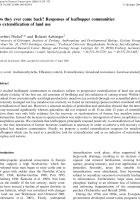Do they ever come back? Responses of leafhopper communities to extensification of land use
Herbert Nickel and Roland Achtziger
Journal of Insect Conservation (2005) 9:319–333
DOI 10.1007/s10841-005-8824-9

Herbert Nickel and Roland Achtziger
Journal of Insect Conservation (2005) 9:319–333
DOI 10.1007/s10841-005-8824-9
Abstract
We studied leafhopper communities in meadows subject to progressive extensification of land use, particularly (i) delay of the first cut, (ii) cessation of fertilising and (iii) reduction of cutting events. Within a gradient from conventionally used high-productivity meadows (as control) through our extensified plots to extensively managed wet hay meadows (as control), we found an increasing species number correlated with extensification of land use. However, a separate analysis of generalists and specialists showed that the latter group increased significantly whereas generalists did not respond at all. Even after 12 years of extensification there was only little evidence for the recovery or recolonisation of former hay meadow insect communities. Instead the increase in species numbers was rather due to immigration of more xerophilous or mesophilous species. We conclude that leafhoppers principally respond positively to extensification of land use, but that restoration of former moisture conditions is necessary in order to achieve a full recovery of original hay meadow communities. Finally we propose a model extensification ecogram for meadow leafhoppers which can be used as a predictive tool for extensification and as an indicator of restoration progress and success.
Download
Do they ever come back? Responses of leafhopper communities to extensification of land use


